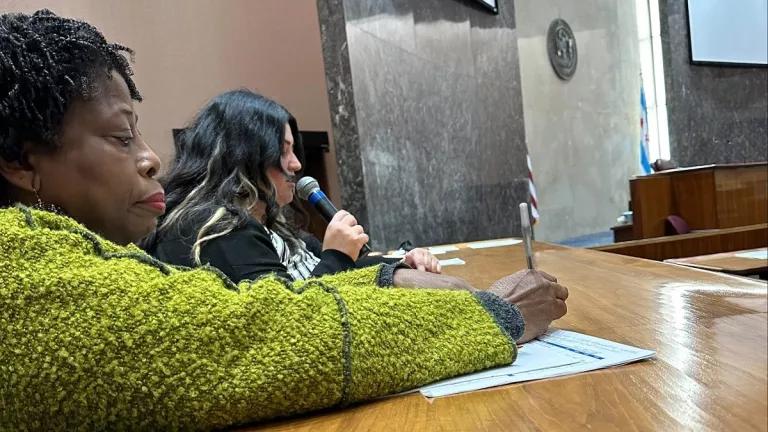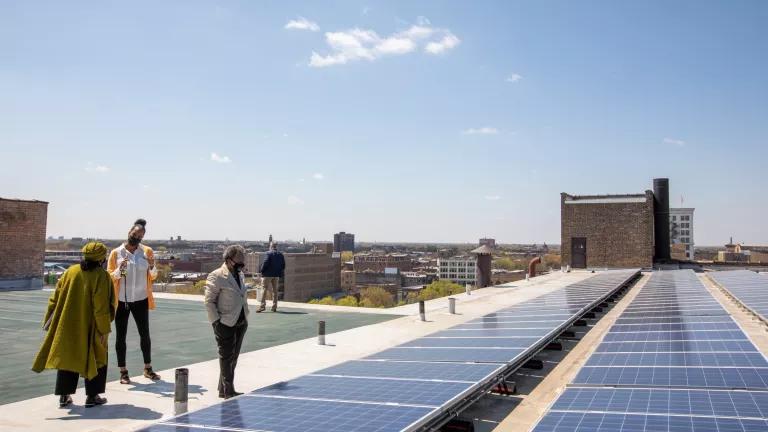How the American Rescue Plan Can Transform Chicago
From reducing pollution burden to reducing gas bills, the Recovery Plan represents an opportunity for Chicago to reach its emissions reductions goals while improving lives.

Gina Ramirez testifying to Alderman Martin and Chair Pat Dowell during a Chicago City Council hearing
Co-authored by Jon Sack
It’s time to turn the tide in Chicago when it comes to environmental and climate justice and community climate investments.
Chicago faces great danger from climate change. More deadly heat waves, increased storms and flooding, erosion of Chicago’s rivers and extreme swings in water levels of Lake Michigan are all threatening Chicago’s future.
These are not far off, distant threats. They are being felt today, and most acutely by disadvantaged communities. Without action they will only get worse.
That’s why we recently testified at a hearing held by Alderman Martin and Chair Pat Dowell where we emphasized that investments in climate infrastructure, energy efficiency, and renewable energy made through the American Rescue Plan in the next two to three years will pay dividends for the next 20 to 30 years and beyond.
Gina Ramirez
Environmental Justice for the Southeast Side
The Southeast Side ranks well above the national average in terms of cancer risk from air toxics, diesel particulates, Superfund site proximity and other environmental justice measures. Residents not only face all these environmental threats, but we also face social and economic disparities—making our community among the most cumulatively burdened in the country.
Communities like the Southeast Side need an equitable distribution of funds from the Local Fiscal Recovery Fund of the American Rescue Plan Act of 2021 for climate and environmental justice investments.
The environmental justice investments in the Recovery Plan represent an important opportunity to begin to repair the environmental racism that has been plaguing communities like mine for decades. Investments in reducing pollution and improving health outcomes via environmental justice hazard reduction programs and tree canopy programs are key starts.
We hope that the City Council does not stop there and doubles down by implementing a cumulative impact pollution ordinance in the future to make sure we end sacrifice zones once and for all in Chicago.
We have disproportionately experienced the cumulative impacts of pollution for far too long. In fact, there are almost 200 industrial facilities that line the South branch of the Chicago River.
The Shroud Superfund site is one of the most toxic areas in the neighborhood. The “coal hills” as they are nicknamed, are stark reminders of our toxic past. Nothing grows on these massive black mounds and they turn Indian creek, which runs through it, neon green in the summer. This site also faces one of our greatest natural gems, Wolfe Lake where residents gather for family picnics and fishing. The dichotomy of toxic industrial waste against their green spaces will hopefully be a tale of the past as we continue to advocate for environmental justice neighborhoods to no longer act as sacrifice zones for industry. Remediation of this site would be a critical step to improving the quality of life in my community.
As the city itself stated, environmental racism is a public health crisis. We strongly urged the city to live up to the promises it outlined in its Healthy Chicago 2025 Plan and the Chicago 2020 Air Quality and Health Report, which include promoting antiracist policies, advancing health equity and creating a future where “communities disproportionately burdened by pollution” will be able to “breathe clean air free of harmful pollutants.” These values and goals must be incorporated into City policies and spending across the board.
As a third-generation Southeast Side native in a city plagued by environmentally racist policies, I’ve grown too accustomed to fighting for basic human rights. Frontline communities like mine unfairly bear the burden of toxic environmental legacies and the lead in drinking water issue is no exception. This is why communities like the Southeast Side and others across Chicago need to be at the front of the line to get our lead pipes replaced so that we can begin to address these issues for our community and for future generations like my son’s.
Southeast Siders are parents, mothers, fathers, children, sons, and daughters. We have lives, responsibilities, and jobs; it shouldn’t be on us to inform ourselves about the impact of industry on our communities.
It also shouldn’t be on us to keep polluters out of our neighborhoods.
Jon Sack
Removing Fossil Fuels from our Buildings
For the City to reach its climate goals, it’s crucial that investments from the Recovery Plan are also used to decarbonize Chicago buildings.
Beginning to decarbonize Chicago’s fleets will not only curb the fossil fuel emissions that are warming our planet and our city, but it will also make Chicago’s air cleaner to breathe and lessen the chronic health impacts of air pollution including childhood asthma, heart disease and cancer that disproportionately affect our frontline communities and communities of color.
Expanding trail networks, mitigating waterway pollution and remediating contaminated land will likewise make Chicago a healthier place to live, work and raise a family.
The community climate investments in the Recovery Plan also represent an important next step in decarbonizing city buildings, including the commitments to expand energy efficiency retrofits in low- and moderate-income homes.
NRDC was proud to work with the City of Chicago on the 2022 Energy Transformation Code, and we applauded its passage by the City Council.

Chicago City Council
Creating cleaner, pollution free buildings is not just good public policy, it is politically popular.
This summer, NRDC commissioned a poll of Chicago voters. The results could not be clearer. Over 70 percent of Chicagoans support a plan for all Chicago buildings to reduce greenhouse gas emissions. Over 60 percent of Chicagoans supported phasing out fossil fuels in newly constructed buildings.
Chicagoans support these policies not just because they will help in the fight against climate change, but also because they will save money and lives.
Gas bills in Chicago are high and are only getting higher. For the average Chicago household, People’s Gas bills are up 44 percent this year alone.
A recent NRDC Residential Building Electrification Analysis found Chicagoans can save thousands of dollars by replacing their gas appliances with efficient, electric appliances. Specifically, the analysis revealed:
- Chicagoans can save more than $10,000 by fully electrifying their homes, even without federal subsidies.
- People with forced air heating who convert their single-family home from gas to all-electric will save more than $13,000 over the next 20 years, or nearly $11,000 in the same time period in a multi-family home—without any federal incentives.
- Chicagoans with low incomes will save more than $20,000 by going all-electric and taking advantage of new federal rebates.
- People with low incomes who qualify for rebates under the Inflation Reduction Act will save more than $24,000 by converting a single-family home with forced air heating to all-electric, or more than $20,000 by converting a home in a multifamily building.
And this is without accounting for all the local rebates and programs for energy efficiency and efficient electrification in low- and moderate-income communities, which will support additional savings.
Going all-electric also slashes carbon pollution from a home in half. In addition to saving people thousands of dollars, all-electric homes emit much less planet-warming carbon pollution than those burning gas. An all-electric home will emit at least 30% less carbon pollution in the first year compared to a home with gas appliances, and at least 50% less over 20 years as the electric grid continues to get cleaner. Partial electrification also significantly reduces carbon pollution.
With buildings accounting for 70 percent of Chicago’s carbon emissions, electrification, combined with deep energy efficiency, will be critical to achieving the Chicago Climate Action plan’s goal of 62 percent carbon emissions reductions by 2040.
That is why the City Council needs to not only pass the community climate investments in the Recovery Plan, but also pass a building performance standard and phaseout fossil fuels in new buildings as recommended in the Chicago Building Decarbonization Policy Working Group Report.
The community climate investments in the Recovery Plan represent an incredible opportunity for Chicago to reach its emissions reductions goals while improving the lives of Chicagoans in the process.




